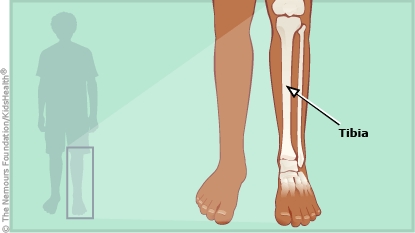The tibia (also called the shinbone) is the larger of the two bones in the lower leg between the knee and the ankle. Your child has a splint to treat a fracture (break) in the bone. A splint is like a cast but doesn't go all the way around the leg. A splint helps fractures by holding the bones in place while they heal. In a few days after the swelling goes down the splint will be changed to a cast.
Take care of the splint and treat pain as instructed to keep your child comfortable while the fracture heals.

- To control swelling, for the first 2 days after the injury:
- Use pillows to raise the splint above heart level when your child is sitting or lying down.
- When your child is awake, put ice in a plastic bag wrapped in a towel on the outside of the splint for 20 minutes every 3 hours for up to 2 days. Don't put ice directly on the splint or skin.
- Remind your child to keep off the leg. If your child has crutches, make sure they're used safely.
- Remind your child to wiggle the toes to keep blood flowing normally.
If your child has pain:
Give your child acetaminophen (Tylenol® or a store brand) or ibuprofen (Advil®, Motrin®, or a store brand) as recommended by the care team. Follow the package directions for how much to give and how often.
Daily splint care:
- Don't remove or change the position of the splint.
- Check the area around the splint every day. Make sure the skin isn't scratched and the fingers aren't pale, blue, numb, or tingling.
- Make sure your child doesn't pick at the lining of the splint or scratch under it.
- Don't put anything in the splint. Make sure your child doesn't put toys, food, or other objects into it.
- Keep dirt, sand, lotion, and powder away from the splint.
- Keep the splint dry:
- No swimming.
- Give sponge baths to kids younger than 5 years old.
- Older kids should take baths instead of showers. Put a plastic covering over the splint when your child bathes. Put the leg and splint on something to keep them completely out of the water.
- If the splint is accidentally splashed, gently blow air onto it from a hair dryer on the cool setting.
Problems to watch for:
- Itching: Tap lightly on the splint or use a hair dryer on the cool setting to blow air in and around the edges.
- Swelling: If the toes look puffy, raise the leg above the level of the heart for 1 hour. If the swelling doesn't get better, call your health care provider.
Be sure to:
- Follow up with the orthopedic specialist as directed.
- Have your child avoid gym class, sports, and playground equipment until the orthopedic specialist says it's OK.

Will my child need a cast? Yes. In a few days after the swelling goes down, the orthopedic specialist will change the splint to a cast. After several weeks, the cast might be changed to a walking boot.
How long does it take a tibia fracture to heal? Healing time varies. Depending on the tibia fracture and the child, kids will need a cast or boot for a total of around 6–12 weeks.




